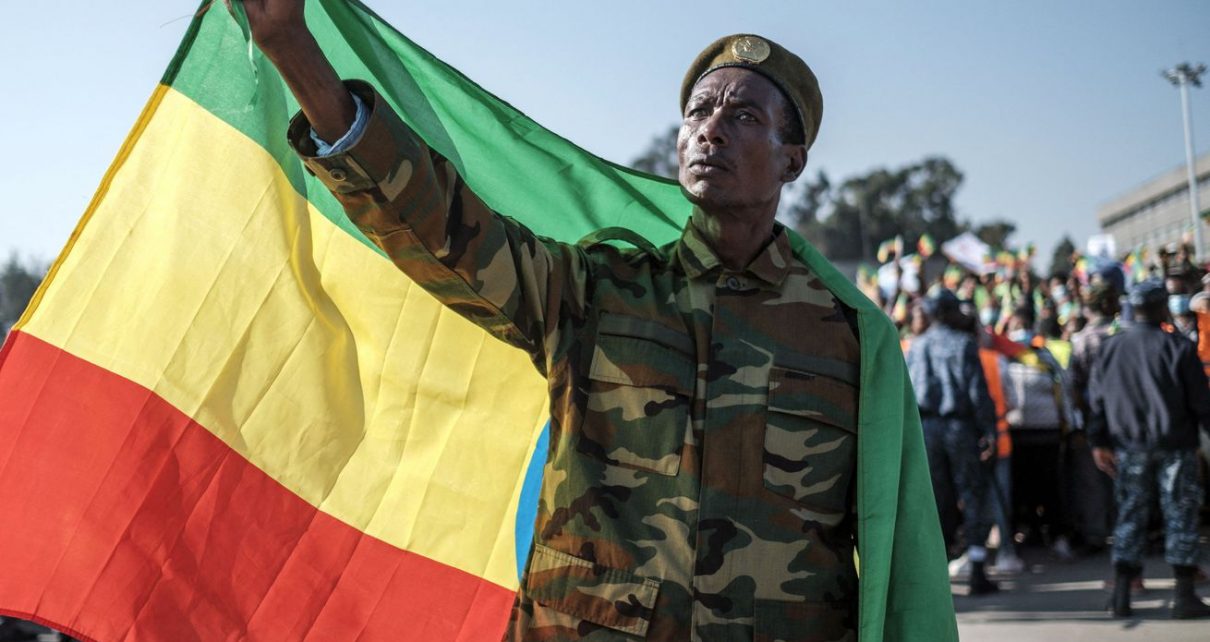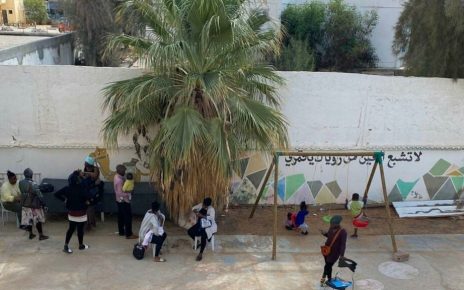
Rebel troops are advancing toward the Ethiopian capital of Addis Ababa.
After a year of conflict, displacement, and growing humanitarian crises, Ethiopia’s civil war entered a new phase this week after a newly formed coalition of Tigrayan rebels and other minority groups began their advance on the federal capital of Addis Ababa.
The civil war, which began in November last year, has already killed thousands and displaced millions more; the UN says there have been brutal human rights violations on all sides, including a federal blockade of badly needed humanitarian aid into the northern Tigray region.
Now, the Tigrayan People’s Liberation Front, or TPLF, has responded by marching on the Ethiopian capital, Addis Ababa, along with a number of other rebel groups that have joined with the TPLF in opposition to Ethiopian Prime Minister Abiy Ahmed. While reports vary regarding their progress toward the capital, rebel forces may be as close as about 100 miles away, a spokesperson for the Oromo Liberation Army told CNN.
TPLF representatives in Washington, DC, announced the new coalition, called the United Front of Ethiopian Federalist and Confederalist Forces, on Friday, and made clear its intention to oust Abiy.
“Time is running out for him,” Berhane Gebrekristos, a former Ethiopian ambassador to the US and a TPLF leader, said during the announcement.
The coalition represents a new chapter in the conflict; previously, the TPLF, while powerful, has nonetheless been a minority force fighting against the federal government, but the advance on Addis Ababa marks a potential shift in the conflict’s momentum.
In addition to the TPLF, there are eight other groups in the new coalition; of those, the OLA is among the most prominent.
The OLA represents the Oromo ethnic group, of which Abiy himself is a member. Previously, Abiy has enjoyed the support of the Oromo and Amhara people; however, a spate of arrests and murders of Oromo leaders and activists, in addition to economic and political marginalization, have turned many Oromo against Abiy.
The seven other factions in the opposition coalition represent other ethnic groups, of which there are about 80 in Ethiopia. Upon his election, Abiy declared his government would distribute resources and power equally; however, the coalition announced their alliance on Friday “in response to the scores of crises facing the country” under his rule.
“The next step will be to organize ourselves and totally dismantle the existing government, either by force or by negotiation … then insert a transitional government,” Mahamud Ugas Muhumed, a representative of the Somali State Resistance, one of the coalition groups, said.
But while the alliance brings together other minority groups, all of which have militant factions, it’s yet unclear how effective the coalition will be in its push to depose Abiy.
“I don’t think it will have that much of an impact,” Gedion Timothewos, Ethiopia’s attorney general and justice minister, said during an online news conference Friday, calling the coalition a “publicity stunt.”
Some external experts, however, disagree. William Davison, a senior analyst with the International Crisis Group, told the New York Times this week that the coalition indicates “that the political tides are changing” in Ethiopia.
If nothing else, the coalition’s advance toward Addis Ababa appears to be causing anxiety in the capital. OLA forces report that they are about 100 miles from Addis Ababa, while other sources put the figure at 200 miles. The coalition also says it has been able to take strategic cities on the way. While the Abiy government says the rebels are exaggerating their victories, the government has also called on retired soldiers to pick up their weapons and fight the advancing forces.
“Dying for Ethiopia is a duty for all of us,” Abiy said last week.
Ethiopia’s civil war is the product of longstanding ethnic tensions
The past month has seen further escalation of the civil war between the Tigrayan forces and Abiy’s administration, which started a year ago when TPLF forces launched what they described as a preemptive strike against a federal military base in Tigray.
Although the Tigrayan people are a minority ethnic group in Ethiopia, with a population of roughly 6 million concentrated in the northern state of Tigray, they emerged as a powerful force in the 1970s against Ethiopia’s Marxist military dictatorship, after years of marginalization.
Eventually, the TPLF dominated the coalition Ethiopian People’s Revolutionary Democratic Front, which overthrew the dictatorship in 1991. Tigrayan politicians led the government and dominated the coalition for nearly 30 years, overseeing economic growth despite famine and conflict in the region.
But the TPLF-led government was also known for torturing detainees and harsh crackdowns on dissent; by the time Abiy emerged on the political scene, anti-government protests had forced the previous prime minister to step down.
In the space of just three years, Abiy purged Tigrayan leadership from the federal government, essentially stripping the group of much of its former political power at a national level.
However, the state of Tigray is still under TPLF control, despite Abiy’s best efforts to centralize power. The TPLF’s resistance to the Abiy government — most notably by holding regional parliamentary elections in September 2020, despite Abiy’s decision to postpone them throughout the country — quickly spiraled into a full-blown conflict.
After early victories for Ethiopia’s national armed forces, the TPLF has been able to push back, recapturing the Tigrayan capital Mekele in June. Now, the group is gaining ground — as well as political and military support — with the new coalition.
But the recent developments have come at great cost for Tigray, as thousands have died in the conflict and 2 million have been displaced, both internally and externally.
A November 3 report from the UN — the most comprehensive thus far in the conflict — also detailed numerous human rights abuses on both sides of the conflict. According to Michelle Bachelet, the UN high commissioner for human rights, Ethiopian national forces, along with their Eritrean allies, were responsible for the bulk of those atrocities.
The war has also created a humanitarian crisis: Aid to Tigray slowed to a trickle in July due to a government blockade which prevented trucks with food, medical supplies, and fuel from entering the region. In September, UN humanitarian aid chief Martin Griffiths warned Tigray was on the verge of famine and called the crisis “a stain on our conscience” in an interview with the Associated Press.
Shortly thereafter, the Ethiopian government moved to expel seven UN officials from the country, accusing them of “meddling” in the nation’s affairs and diverting humanitarian aid to TPLF forces. The government had previously ordered the Dutch contingent of Médecins Sans Frontières (Doctors Without Borders), as well as the Norwegian Refugee Council, to cease operations.
In October, Ethiopian national defense forces began conducting airstrikes in Mekele, which have killed multiple children. While Abiy’s government has claimed it was targeting military installations, some witnesses say the airstrikes actually hit civilian targets. The central government denied intentionally targeting civilians, according to Reuters, and communications blackouts in the region make verification difficult.
After a year of war, the US is stepping up its response
So far, Western leaders have made statements calling for an end to hostilities and warning of the dire humanitarian situation, but now are beginning to back up their admonitions with real consequences for Ethiopia’s central government.
Notably, the US suspended Ethiopia from the African Growth and Opportunity Act, or AGOA, on Tuesday “for gross violations of internationally recognized human rights.”
AGOA allows certain countries to export goods duty-free to the US, and suspending Ethiopia’s participation will be a serious economic blow; last year, Ethiopia shipped $245 million worth of goods to the US under AGOA, according to Al Jazeera — nearly half all its exports to the US.
President Joe Biden’s administration has also sent Jeffrey Feltman, its Horn of Africa envoy and a veteran diplomat, to try and negotiate a deescalation to the conflict after Abiy declared a six-month state of emergency earlier this month. However, Feltman told Reuters, “We’re not getting much response, the military logic is still prevailing.”
Biden has threatened further sanctions against Ethiopian leadership, and a bipartisan group of senators has put forward legislation specifically targeting the actors prolonging and benefiting from the conflict, but as Politico’s Nahal Toosi points out, both sides of the conflict seem unwilling to budge.
“The problem is that you have multiple objects that heretofore have proven largely unmovable,” Toosi quotes an unnamed State Department official as saying about the situation. “It remains to be seen whether the shifting dynamic will cause at least one of those objects to show a little more flexibility.”





